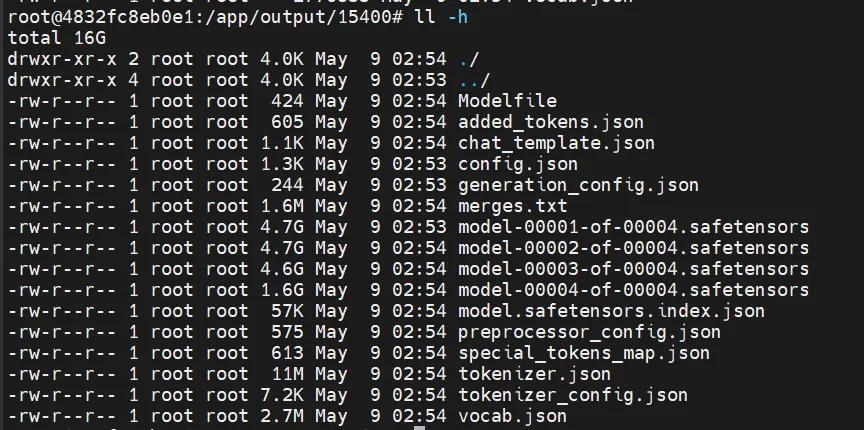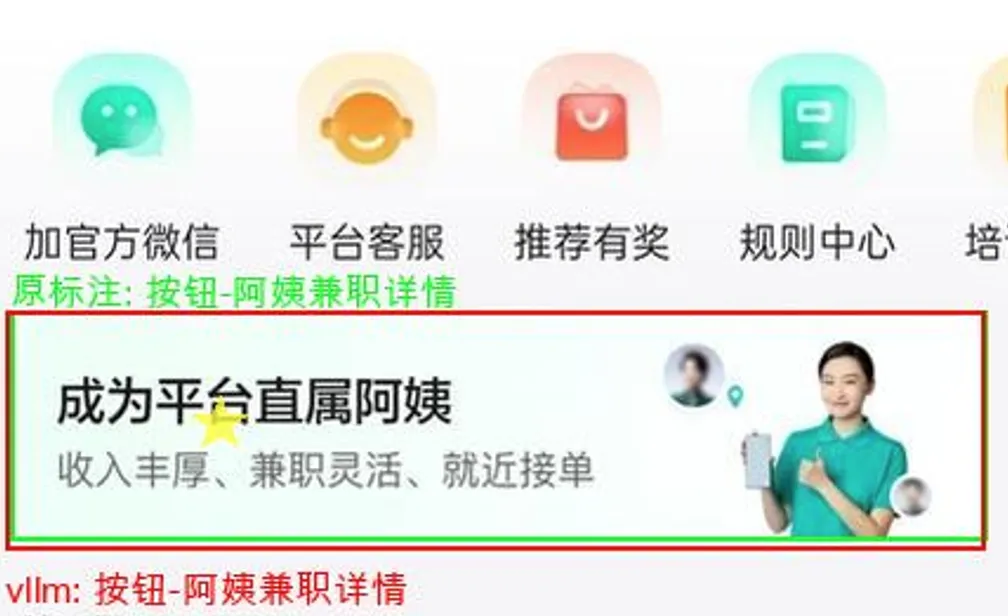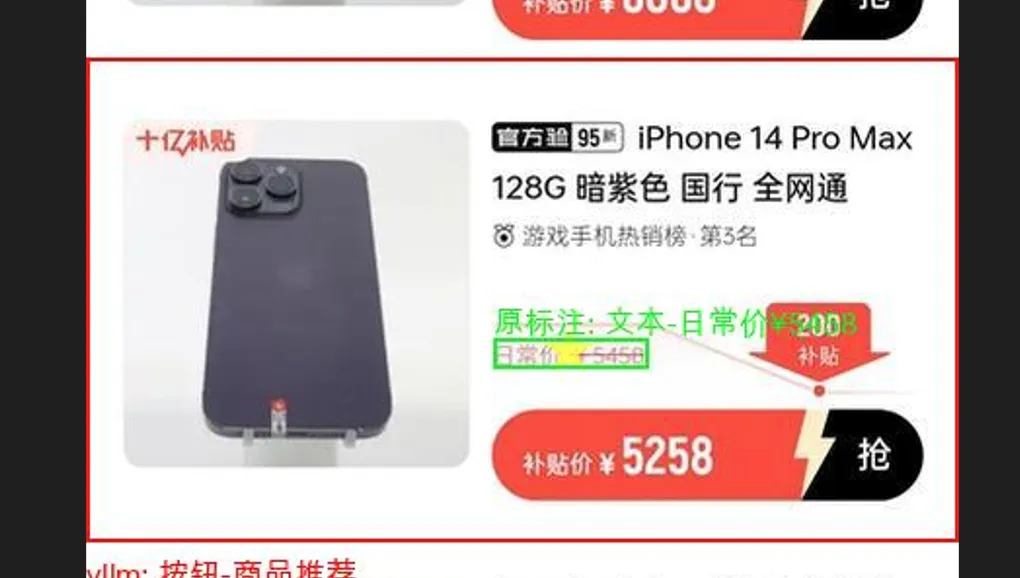目录
【训练】Qwen2.5VL 多机多卡 Grounding Box定位(1):http://101.126.150.28:7878/post/2067
【训练】Qwen2.5VL 多机多卡 Grounding Box定位(2):http://101.126.150.28:7878/post/2094
之前的相关文章:
【深度学习】LLaMA-Factory微调sft Qwen2-VL进行印章识别
https://www.dong-blog.fun/post/1661
使用LLaMA-Factory微调sft Qwen2-VL-7B-Instruct
https://www.dong-blog.fun/post/1762
构建最新的LLaMA-Factory镜像
https://www.dong-blog.fun/post/1799
关于Grounding 如何不偏移的问题解决
看了一些帖子:
- https://github.com/QwenLM/Qwen2.5-VL/issues/1094
- https://github.com/QwenLM/Qwen2.5-VL/issues/950
- https://github.com/QwenLM/Qwen2.5-VL/issues/900
- https://github.com/QwenLM/Qwen2.5-VL/issues/866
- https://github.com/QwenLM/Qwen2.5-VL/issues/721
- https://github.com/QwenLM/Qwen2.5-VL/issues/584
- https://github.com/QwenLM/Qwen2.5-VL/issues/830
- https://github.com/QwenLM/Qwen2.5-VL/issues/773
所以有一些关于 Qwen2.5VL Grounding 的结论:
- 官方微调用的是这样的格式,所以在prompt中也无需特殊的格式/
json展开代码[
{"bbox_2d": [x1, y1, x2, y2], "label": "obj_name/description"},
{"bbox_2d": [x1, y1, x2, y2], "label": "obj_name/description"},
{"bbox_2d": [x1, y1, x2, y2], "label": "obj_name/description"},
]
-
官方还是这么做了,因为底层对28的切割性质,所以要这么做,不然真会偏一点: 在 Qwen2.5-VL 中,我们首先调整输入图像的大小,以确保其宽高为 28*n,然后使用调整后图像上的绝对坐标作为最终目标。
-
使用 (左, 上), (右, 下) 坐标,不用归一化到0-1000.
-
您好,根据您的描述,我怀疑问题出在 Qwen2-VL 和 Qwen2.5-VL 中 bbox 坐标的处理方式不同。具体来说,我们在 Qwen2.5-VL-7B 中现在使用的是绝对坐标,而不是 Qwen2-VL 中使用的相对坐标(后者被缩放到 [0,1000])。 例如,在 Qwen2-VL 中,640x640 图像中 [0, 0, 320, 320] 的边界框用 (0, 0), (500, 500) 表示。但在 Qwen2.5-VL 中,我们直接使用 [0, 0, 320, 320] 或 (0,0),(320,320)。此外,如果在图像增强过程中将图像尺寸调整为 1280x1280,则坐标现在应相应地扩展为 [0, 0, 640, 640]。
由于 Qwen2.5-VL 使用绝对坐标进行训练,我建议在微调时也使用相同的绝对坐标系。如果您出于某种原因坚持使用相对坐标,可以延长训练时间,看看偏差问题是否会随着训练时间的延长而消失。
供大家参考,详细坐标流程如下:
调整图像大小,使高度和宽度为 28*n resized_w, resized_h = smart_resize(img_w, img_h) 相应地改变绝对坐标 new_bbox = bbox / np.array([img_w, img_h, img_w, img_h]) * np.array([resized_w, resized_h, resized_w, resized_h])) 如果使用绝对坐标后仍然观察到明显的 grounding 偏差,则另一个可能的问题在于图像的大小。如果图像非常大或非常小(例如,> 4k 4k 或 < 320 320),则模型很可能会输出有偏差的 bbox 结果。
-
新版本的transformers才没有rope问题,安装: pip install git+https://github.com/huggingface/transformers
对自己图像的处理
调整图像大小,使高度和宽度为 28 * n 。坐标使用绝对坐标,无需特殊格式。使用正确的transformer版本。
llamafactory 的数据要求:
https://llamafactory.readthedocs.io/zh-cn/latest/getting_started/data_preparation.html#id16
llamafactory 如何解析这类数据:
https://www.dong-blog.fun/post/2077
我的数据样本 xdx_b_intervl8btrain_28.json
展开代码{ "messages": [ { "content": "<image>点[56,259]所处位置的信息是什么?", "role": "user" }, { "content": "<ref>文本-地址</ref><box>[[33, 241, 66, 264]]</box>", "role": "assistant" } ], "images": [ "/img_datasets/img_small_size_28/didichuxing-20240914171548.jpg" ] }
对应的dataset_info.json中的描述应该是:
展开代码{ "grounding1": { "file_name": "xdx_b_intervl8btrain_28.json", "formatting": "sharegpt", "columns": { "messages": "messages", "images": "images" }, "tags": { "role_tag": "role", "content_tag": "content", "user_tag": "user", "assistant_tag": "assistant" } } }
启动训练
bash展开代码cd LLaMA-Factory
docker run -it --gpus '"device=0,2,3,4,5,6,7"' \
-v /data/xiedong/train_qwenvl25_for_grounding/data:/app/data \
-v ./output:/app/output \
-v ./examples:/app/examples \
-v /data/xiedong/train_qwenvl25_for_grounding:/img_datasets \
-v /data/xiedong/vlm_r1_train_tools/Qwen2.5-VL-7B-Instruct:/Qwen2.5-VL-7B-Instruct \
--shm-size 32G \
-p 8034:7860 \
-p 8035:8000 \
kevinchina/deeplearning:llamafactory20250311-3-swanlab bash
装个swanlab:
展开代码pip install swanlab -i https://mirrors.tuna.tsinghua.edu.cn/pypi/web/simple
可以打开webui看一下:
展开代码llamafactory-cli webui
单机训练:
展开代码export SWANLAB_API_KEY=pM7Xvs5OS2EeXPO5gKXfJ # 设置在线跟踪模式API,这里我随便填的 export SWANLAB_LOG_DIR=/swanlab_log # 设置本地日志存储路径 export SWANLAB_MODE=cloud # 包含四种模式:cloud云端跟踪模式(默认)、cloud-only仅云端跟踪本地不保存文件、local本地跟踪模式、disabled完全不记录用于debug llamafactory-cli train \ --stage sft \ --do_train True \ --model_name_or_path output/18800 \ --preprocessing_num_workers 64 \ --finetuning_type full \ --template qwen2_vl \ --flash_attn auto \ --dataset_dir data \ --dataset grounding1 \ --cutoff_len 4096 \ --learning_rate 5e-05 \ --num_train_epochs 2.0 \ --per_device_train_batch_size 1 \ --gradient_accumulation_steps 4 \ --lr_scheduler_type cosine \ --max_grad_norm 1.0 \ --logging_steps 5 \ --save_steps 1000 \ --warmup_steps 0 \ --packing False \ --report_to none \ --output_dir output/new_no_freeze \ --bf16 True \ --plot_loss True \ --trust_remote_code True \ --ddp_timeout 180000000 \ --include_num_input_tokens_seen True \ --optim adamw_torch \ --deepspeed cache/ds_z2_config.json \ --use_swanlab True \ --swanlab_project llamafactory \ --swanlab_mode cloud \ --save_total_limit=1 \ --load_best_model_at_end=False \ --metric_for_best_model="eval_loss" \ --greater_is_better=False \ --freeze_vision_tower False \ --image_max_pixels 1048576
llamafactory 默认情况下 freeze_vision_tower 是True,冻结了视觉编码。在Grounding 定位里,我只训练LLM,似乎结果很差。
如果要限制训练样本数量:
展开代码--max_samples 100000 \
如果要有验证集:
展开代码--val_size 0.1 \ --eval_strategy steps \ --eval_steps 100 \ --per_device_eval_batch_size 2 \
如果要用swanlab:
展开代码export SWANLAB_API_KEY=pM7Xvs5OS2EeXPO5gKXfJ # 设置在线跟踪模式API,这里我随便填的 export SWANLAB_LOG_DIR=/swanlab_log # 设置本地日志存储路径 export SWANLAB_MODE=cloud # 包含四种模式:cloud云端跟踪模式(默认)、cloud-only仅云端跟踪本地不保存文件、local本地跟踪模式、disabled完全不记录用于debug
展开代码--use_swanlab True \ --swanlab_project llamafactory \ --swanlab_mode cloud \
训练结束
损失基本处于收敛状态:

模型导出
这样就可以导出了:
展开代码llamafactory-cli export \ --model_name_or_path output/Qwen2.5-VL-7B-Instruct/full/train_2025-05-08-07-28-25/checkpoint-18800/ \ --template qwen2_vl \ --finetuning_type lora \ --export_dir output/18800 \ --export_size 5 \ --export_device cpu \ --export_legacy_format false
导出后的样子:

模型部署
展开代码docker run -d --gpus '"device=2,3"' \ -v /data/xiedong/LLaMA-Factory/output/train2-28488:/model \ -p 8056:8000 \ --ipc=host \ --shm-size 32g \ vllm/vllm-openai:latest \ --model /model --gpu_memory_utilization 0.8 --tensor_parallel_size 2 --served-model-name "qwen2vl" --max_model_len 4096 \ --enable-prompt-tokens-details
展开代码-e "VLLM_LOGGING_LEVEL=DEBUG"
请求vllm api
展开代码def api_request(image, point_coords): """Send request to API endpoint""" url = "http://10.150.72.28:8066/v1/chat/completions" headers = {"Content-Type": "application/json"} payload = { "model": "qwen2vl", "messages": [ { "role": "user", "content": [ { "type": "text", "text": f"点[{point_coords[0]},{point_coords[1]}]所处位置(也即是图中绿色五角星中心所处位置)的信息是什么?需要优先匹配最近UI元素的box。" }, { "type": "image_url", "image_url": { "url": f"data:image/jpeg;base64,{image_to_base64(image)}" } } ] } ], "max_tokens": 2048, "temperature": 0.1, "top_p": 0.9, "top_k": 50, "n": 1, "stream": False } response = requests.post(url, headers=headers, data=json.dumps(payload)) return response.json()
得到的box不准确,直接用官方的推理代码进行尝试。
官网推理代码
执行代码,看来不是代码问题。得到的box还是不准确。
展开代码docker run -it --gpus '"device=1"' \ --shm-size 32G \ -v /ssd/xiedong/qwenvl_train_ui_ground_datasets:/ssd/xiedong/qwenvl_train_ui_ground_datasets \ -v /ssd/xiedong/qwenvl25train_15400:/ssd/xiedong/qwenvl25train_15400 \ kevinchina/deeplearning:llamafactory20250311-3-swanlab bash
展开代码pip install qwen-vl-utils[decord]
展开代码cd /ssd/xiedong/qwenvl_train_ui_ground_datasets python compare_annotations_local.py
python:
python展开代码import base64
import json
import re
import os
import argparse
import random
from PIL import Image, ImageDraw, ImageFont
from collections import defaultdict
# Import necessary libraries for local model inference
from transformers import AutoProcessor
from vllm import LLM, SamplingParams
from qwen_vl_utils import process_vision_info
# 全局变量存储模型实例
global_llm = None
global_processor = None
def parse_box_coordinates(box_str):
"""解析边界框坐标字符串"""
# 移除所有空格并分割
coords_str = box_str.replace(' ', '')
# 使用正则表达式提取坐标
numbers = re.findall(r'\d+', coords_str)
return list(map(int, numbers))
def init_model(model_path, max_model_len):
"""初始化模型(只执行一次)"""
global global_llm, global_processor
print(f"正在加载模型 {model_path}...")
global_llm = LLM(
model=model_path,
limit_mm_per_prompt={"image": 10, "video": 10},
max_model_len=max_model_len
)
global_processor = AutoProcessor.from_pretrained(model_path)
print("模型加载完成!")
return global_llm, global_processor
def infer_with_model(image_path, point_x, point_y):
"""使用全局模型进行推理"""
global global_llm, global_processor
# 确保模型已初始化
if global_llm is None or global_processor is None:
raise ValueError("模型尚未初始化")
# 采样参数
sampling_params = SamplingParams(
temperature=0.1,
top_p=0.001,
repetition_penalty=1.05,
max_tokens=1024,
stop_token_ids=[],
)
# 准备消息
messages = [
{"role": "system", "content": "You are a helpful assistant."},
{
"role": "user",
"content": [
{"type": "text", "text": f"点[{point_x},{point_y}]所处位置的信息是什么?"},
{
"type": "image",
"image": image_path,
"min_pixels": 224 * 224,
"max_pixels": 1280 * 28 * 28,
},
],
},
]
# 处理消息
prompt = global_processor.apply_chat_template(
messages,
tokenize=False,
add_generation_prompt=True,
)
# 处理视觉信息
image_inputs, video_inputs, video_kwargs = process_vision_info(messages, return_video_kwargs=True)
mm_data = {}
if image_inputs is not None:
mm_data["image"] = image_inputs
# 准备输入并生成
llm_inputs = {
"prompt": prompt,
"multi_modal_data": mm_data,
"mm_processor_kwargs": video_kwargs,
}
# 执行推理
outputs = global_llm.generate([llm_inputs], sampling_params=sampling_params)
generated_text = outputs[0].outputs[0].text
return generated_text
def main():
"""主函数"""
# 解析命令行参数
parser = argparse.ArgumentParser(description='对比本地模型和标注数据集中的边界框')
parser.add_argument('--dataset', type=str, default='xdx_b_intervl8btrain_28.json', help='数据集文件路径')
parser.add_argument('--img-dir', type=str, default='img_small_size_28', help='图像目录')
parser.add_argument('--output-dir', type=str, default='comparison_results', help='输出目录')
parser.add_argument('--font', type=str, default='Arial-Unicode-Regular.ttf', help='字体文件路径')
parser.add_argument('--limit', type=int, default=200, help='处理的样本数量上限')
parser.add_argument('--model-path', type=str, default='/ssd/xiedong/qwenvl25train_15400', help='模型路径')
parser.add_argument('--max-model-len', type=int, default=2048, help='模型最大上下文长度')
args = parser.parse_args()
# 创建输出目录
output_dir = args.output_dir
os.makedirs(output_dir, exist_ok=True)
print(f"开始处理数据集 {args.dataset}...")
try:
# 首先初始化模型(只进行一次)
init_model(args.model_path, args.max_model_len)
# 加载数据集
with open(args.dataset, 'r', encoding='utf-8') as f:
data = json.load(f)
print(f"成功加载数据集,共 {len(data)} 个样本")
# 限制处理的样本数量
sample_count = min(args.limit, len(data)) if args.limit > 0 else len(data)
samples_to_process = random.sample(data, sample_count)
print(f"将随机处理 {sample_count} 个样本")
# 加载字体
font_path = args.font
try:
font = ImageFont.truetype(font_path, 16)
print(f"成功加载字体: {font_path}")
except IOError:
print(f"警告: 无法加载字体 {font_path},使用默认字体")
font = ImageFont.load_default()
# 处理每个样本
for i, sample in enumerate(samples_to_process):
try:
# 获取图像路径
image_path = sample['images'][0].replace('/img_datasets/', '')
full_image_path = os.path.join(args.img_dir, os.path.basename(image_path))
if not os.path.exists(full_image_path):
print(f"警告: 图像 {full_image_path} 不存在,跳过")
continue
# 获取用户消息和助手消息
user_message = sample['messages'][0]['content']
assistant_message = sample['messages'][1]['content']
# 解析用户消息中的点坐标
point_match = re.search(r'\[(\d+),\s*(\d+)\]', user_message)
if not point_match:
print(f"警告: 无法从用户消息中解析点坐标: {user_message}")
continue
point_x, point_y = int(point_match.group(1)), int(point_match.group(2))
# 解析助手消息中的引用文本和边界框
ref_match = re.search(r'<ref>(.*?)</ref>', assistant_message)
box_match = re.search(r'<box>\[(.*?)\]</box>', assistant_message)
if not (ref_match and box_match):
print(f"警告: 助手消息中缺少引用文本或边界框: {assistant_message}")
continue
ref_text = ref_match.group(1)
# 解析标注数据集中的边界框坐标
annotation_box_coords = parse_box_coordinates(box_match.group(1))
print(f"处理样本 {i+1}/{sample_count}: {full_image_path}")
print(f" 点坐标: [{point_x}, {point_y}]")
print(f" 标注文本: {ref_text}")
print(f" 标注边界框: {annotation_box_coords}")
# 使用全局模型进行推理
model_response = infer_with_model(full_image_path, point_x, point_y)
# 解析模型响应
vllm_ref_match = re.search(r'<ref>(.*?)</ref>', model_response)
vllm_box_match = re.search(r'<box>\[(.*?)\]</box>', model_response)
if not (vllm_ref_match and vllm_box_match):
print(f" 警告: 模型返回内容缺少引用文本或边界框: {model_response}")
continue
vllm_ref_text = vllm_ref_match.group(1)
vllm_box_coords = parse_box_coordinates(vllm_box_match.group(1))
print(f" 模型文本: {vllm_ref_text}")
print(f" 模型边界框: {vllm_box_coords}")
# 打开图像并准备绘制
img = Image.open(full_image_path)
draw = ImageDraw.Draw(img)
# 绘制点 - 黑色实心圆点
point_radius = 5
draw.ellipse((point_x-point_radius, point_y-point_radius,
point_x+point_radius, point_y+point_radius),
fill=(0, 0, 0), outline=(255, 255, 255))
# 绘制标注数据集中的边界框 - 绿色
if len(annotation_box_coords) == 4:
x1, y1, x2, y2 = annotation_box_coords
draw.rectangle([x1, y1, x2, y2], outline=(0, 255, 0), width=2)
# 在边界框上方添加标注文本
draw.text((x1, y1-20), f"原标注: {ref_text}", font=font, fill=(0, 255, 0))
# 绘制模型预测的边界框 - 红色
if len(vllm_box_coords) == 4:
x1, y1, x2, y2 = vllm_box_coords
draw.rectangle([x1, y1, x2, y2], outline=(255, 0, 0), width=2)
# 在边界框下方添加模型文本
draw.text((x1, y2+5), f"模型: {vllm_ref_text}", font=font, fill=(255, 0, 0))
# 保存结果图像
output_filename = f"compare_{i+1}_{os.path.basename(image_path)}"
output_path = os.path.join(output_dir, output_filename)
img.save(output_path)
print(f" 已保存结果图像: {output_path}")
except Exception as e:
print(f"处理样本 {i+1} 时出错: {e}")
print(f"\n处理完成. 结果已保存到目录: {os.path.abspath(output_dir)}")
except Exception as e:
print(f"发生错误: {e}")
if __name__ == "__main__":
main()
第一次训练结果
训练还没有结束,但对比训练的最开始和现在,模型效果得到了很大改善。

改善点:对于没有歧义的内容效果不错,box没有产生偏移,说明Qwen2.5VL具有Grounding Box定位能力(只要照片宽高是28 * n)。图中五角星中心是给入的Query点,绿色是 label grounding box, 红色则是Qwen2.5VL 给出的box。

失败点:框的语义混淆。(准备向Query里加提示改善,但肯定不能完全ok,想着可以多要按钮的)

失败点:错误识别给入的x和y了。(准备向图片里加个什么五角星,辅助模型在图里的定位)



本文作者:Dong
本文链接:
版权声明:本博客所有文章除特别声明外,均采用 CC BY-NC。本作品采用《知识共享署名-非商业性使用 4.0 国际许可协议》进行许可。您可以在非商业用途下自由转载和修改,但必须注明出处并提供原作者链接。 许可协议。转载请注明出处!